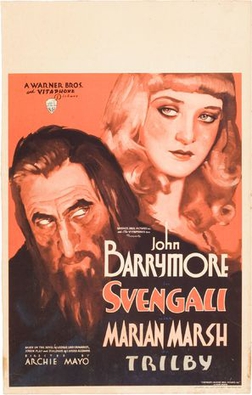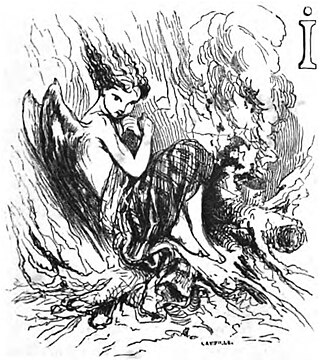A trilby is a narrow-brimmed hat with an indented crown.
Contents
Trilby may also refer to:
A trilby is a narrow-brimmed hat with an indented crown.
Trilby may also refer to:

Dame Daphne du Maurier, Lady Browning, was an English novelist, biographer and playwright. Her parents were actor-manager Sir Gerald du Maurier and his wife, actress Muriel Beaumont. Her grandfather George du Maurier was a writer and cartoonist.
This is an overview of 1923 in film, including significant events, a list of films released and notable births and deaths.
The year 1916 in film involved some significant events.
The year 1914 in film involved some significant events, including the debut of Cecil B. DeMille as a director.
The year 1912 in film involved some significant events.
The year 1911 in film involved some significant events.

George Louis Palmella Busson du Maurier was a Franco-British cartoonist and writer known for work in Punch and a Gothic novel Trilby, featuring the character Svengali. His son was the actor Sir Gerald du Maurier. The writers Angela du Maurier and Daphne du Maurier and the artist Jeanne du Maurier were all granddaughters of George. He was also father of Sylvia Llewelyn Davies and grandfather of the five boys who inspired J. M. Barrie's Peter Pan.

Jean Charles Emmanuel Nodier was a French author and librarian who introduced a younger generation of Romanticists to the conte fantastique, gothic literature, and vampire tales. His dream related writings influenced the later works of Gérard de Nerval.

Trilby is a sensation novel by George du Maurier and one of the most popular novels of its time. Published serially in Harper's New Monthly Magazine from January to August 1894, it was published in book form on 8 September 1894 and sold 200,000 copies in the United States alone. Trilby is set in the 1850s in an idyllic bohemian Paris. Though Trilby features the stories of two English artists and a Scottish artist, one of the most memorable characters is Svengali, a rogue, masterful musician and hypnotist.

Svengali is a character in the novel Trilby which was first published in 1894 by George du Maurier. Svengali is a Jewish man who seduces, dominates and exploits Trilby, a young half-Irish girl, and makes her into a famous singer.

Sir Gerald Hubert Edward Busson du Maurier was an English actor and manager. He was the son of author George du Maurier and his wife, Emma Wightwick, and the brother of Sylvia Llewelyn Davies. In 1903, he married the actress Muriel Beaumont, with whom he had three daughters: writers Angela du Maurier (1904–2002) and Dame Daphne du Maurier (1907–1989), and painter Jeanne du Maurier (1911–1997). His popularity was due to his subtle and naturalistic acting: a "delicately realistic style of acting that sought to suggest rather than to state the deeper emotions". His Times obituary said of his career: "His parentage assured him of engagements in the best of company to begin with; but it was his own talent that took advantage of them."

Svengali is a 1931 American pre-Code drama film directed by Archie Mayo. The film stars John Barrymore and Marian Marsh. It is based on the 1894 George du Maurier novel Trilby and was among the many film adaptations of the book. The film was shot from January 12 to February 21, 1931. On its release in the United States, Svengali received some positive reviews but did not perform well at the box office.

Svengali is a 1954 British drama film directed and written by Noel Langley and starring Hildegard Knef, Donald Wolfit and Terence Morgan. It was based on the 1894 novel Trilby by George du Maurier. Svengali hypnotises an artist's model into becoming a great opera singer, but she struggles to escape from his powers. It was distributed in the United States by Metro-Goldwyn-Mayer.
Trilby is a 1914 British silent drama film directed by Harold M. Shaw and starring Herbert Beerbohm Tree, Viva Birkett, and Charles Rock. It is based on Tree's 1895 stage production of Trilby, itself an adaptation of the 1894 novel of the same name by George du Maurier.

Svengali is a 1927 German silent drama film directed by Gennaro Righelli and starring Paul Wegener, Anita Dorris and André Mattoni. It was produced and written by Max Glass, an adaptation of the 1894 George du Maurier novel Trilby. This is one of the adaptations of the novel that shifts the focus of the story more to Svengali, since at this time anti-Semitism was on the rise in Germany, and Svengali was portrayed as an evil Jew in the film.
Trilby is a stage play by Paul M. Potter based on the 1894 novel Trilby by George du Maurier. In the play, a young Irish woman, Trilby O'Ferrall, falls under the control of Svengali, who uses hypnosis to make her abandon her fiancé and become a singer.

Trilby is a 1915 American silent drama film directed by Maurice Tourneur and starring Wilton Lackaye, Clara Kimball Young, and Paul McAllister. It is an adaptation of the 1894 novel Trilby by George du Maurier. The film's sets were designed by art director Ben Carré.

Trilbyana or Trilby-Mania was the fashion for things based on the story Trilby by George du Maurier. This was especially popular during the 1890s. The works included burlesques, cartoons, movies, parodies, plays, sketches and tableaux.

Trilby is a 1923 American silent drama film directed by James Young and starring Andrée Lafayette, Creighton Hale, and Arthur Edmund Carewe. It is an adaptation of the 1894 novel Trilby by George du Maurier about a young woman named Trilby who falls under the power of the domineering mesmerist Svengali.

Trilby; or, The Fairy of Argyll is an 1822 literary fairy tale novella by French author Charles Nodier (1780–1844). In it, a Scottish household spirit falls in love with the married woman of the house, who at first has him banished, then misses him, and eventually returns his love, both of them dying at the end. It was a popular work of the Romantic movement, published in multiple editions and translations. It also gave birth to adaptations as multiple ballets, including La Sylphide, and Trilby, and the opera The Mountain Sylph, some of which only retained the basic idea of love between a fairy and a Scottish peasant, but otherwise greatly diverged from the original plot.